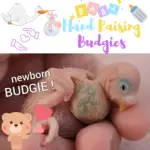
Budgie mate: You might be interested in breeding budgies and you’re right! However, it takes a lot of knowledge. You will also have to take care of their happiness and well-being to make them want to start a happy family.
Preparing for the arrival of chicks
Decide if you really want to do it
Find a suitable part
Organize the cage
Choose as large as possible, but take at least 75 cm long and 75 cm high. The cage can be wider than high (budgies fly horizontally), it must be rectangular and have at least three doors: one to install food, one to install the nest, and one that gives you easy access inside.
- Install the litter box. You can install a suitable litter made of paper towels, pine chips, straw, or even rabbit or hamster litter if desired.
Get the necessary equipment
You need to prepare the necessary equipment for budgies to mate, not forgetting the one that babies will need. Here’s what you should prepare.
- Two or three perches. Make sure they are made of natural wood which is not dangerous for budgies.
- Several toys for the male. Make sure you don’t put too many in the cage and don’t bring them too close together so that the male doesn’t get hurt. It is also advisable not to put toys with ropes in the cage, as budgies and their chicks could get stuck there.
- A feeder.
- Water bowls, including one more for the chicks when they start to cover themselves with feathers.
- Food for budgies or a mixture for canaries.
- Pellets for budgies.
- A cuttlefish bone for their calcium intake.
- Liquid or powdered calcium (you must have at least two sources of calcium).
- A mineral block (optional).
- More food when babies start flying.
- Food for baby budgies.
- A small syringe.
- An additional cage when the chicks have grown.
Set up a place for abandoned chicks
Add the nest
Parakeets need a comfortable place to lay eggs and raise offspring.
Buy or make a nest out of a box.
Try to make one at least 22 cm high, 20 cm wide, and 15 to 17 cm deep with a hole at the entrance 5 cm in diameter.
- Be sure to place a small dish in it so that the eggs do not roll out of the box or away from the warmth of their mother. It is important that the eggs do not get cold.
Make a nest out of empty coconuts
If you wish, you can make your own nest with empty coconuts. It is an ideal choice because they are comfortable and allow budgies to bite them if they feel like it.
- Three empty coconuts. All three must be the same size.
- Drill holes in one of the coconuts. Make a hole on the top of the coconut, another on one side, and a last one on the other side.
- Repeat with the other two coconuts.
- Assemble them using wire or string that is safe for birds. Run it through the holes.
- Drill a hole in the front to hang the coconut. You can also do it where it seems most convenient to you.
- Hang the empty coconut in the cage.
- Add materials for the nest in the box, for example, pine chips
Choose the pair of budgies
Find a suitable couple
The couple must be more than one year old and not more than five years old. They must be healthy and not have malformations, for example, legs too far apart.
- You should also buy a couple who grew up in the same cage so they already know each other. If you don’t buy one that comes from the same cage, you’re going to have to spend time trying to get them used to each other and you’re going to waste even more time.
- You can buy healthy budgies from a pet store or from a reputable breeder. A good pair of birds must be alert, awake, and make a lot of noise because unhealthy birds will be asleep and crowded and their eyes will be opaque.
- If you want eggs to eat (i.e. sterile eggs), do not buy males. You just need to have a female who will lay eggs that you can eat, if you really want to eat budgie eggs…
Make sure you take good care of it
If you want to mate budgies, you want to have cubs that come from healthy animals that you take good care of. This way you make sure you get chicks!
- You need to clean everything, including the cage, litter, feeders, and water containers. Depending on the number of birds in the cage, you need to give them enough space and not cram them.
- Feeders should be filled with food, and budgies should be given a balanced diet of seeds, fresh fruits, vegetables, grains, etc. Water containers should be filled with fresh, clean water.
Give them time to get used to it
Find a veterinarian who specializes in birds
If you don’t already have one, you need to find one. Keep their contact information handy, including a phone number. You can never know if something is going to go wrong and if it is, call him.
- It is also useful to have your budgies examined by a specialized veterinarian to make sure they are not sick and can mate.
Taking care of the couple
Give them food every day
A good diet consists of fruits, vegetables, seeds, grains, etc. You can also buy a mixture or pellets for budgies or canaries that you give them in addition to fruits and vegetables.
- Be aware that they will eat much more when the chicks hatch, which is why you need to give them more food shortly before hatching.
Give them plenty of fresh water
Clean the cage once a week
Mating budgies
Hold on
Put the eggs
When you see that the female has laid, wait five days before marking the eggs. Egg candling is a technique that tells you which eggs are fertile or sterile. You will find the necessary steps online. Take it easy and avoid touching the eggs. If you must touch them, wash your hands first to avoid transmitting bacteria.
- Be aware that this step is optional. It is recommended that you do some research before you decide to do so.
Caring for chicks
Check the nest regularly
The eggs should hatch after 20 days, which is why it is very important to check the nest every day. Try to do this when the female is out to feed. Temporarily block the entry to the box (e.g. with a piece of newspaper). This prevents the female from attacking and biting you.
- Gently examine the chicks for signs of injury, seeds, or air bubbles in the crop (the pouch at the base of the birds’ necks).
- Observe if the crop is full and inflated.
- Make sure there is no food stuck in the top of the upper mandible (the top of the beak). If you see food, try removing it with a match or the tip of the penne of a feather.
- Clean droppings and food that may be around paws, beaks, eyes or other parts of the body with a soft, damp, warm cloth.
- Discard any dead chicks you find in the nest.
Feel free to touch them
Observe the chicks and the female
Clean the nest and cage daily
Give them millet
Preparing for feather growth
All you need to know about preparing for feather growth
Give seeds to the chicks
When the chicks finally cover themselves with feathers between the 28th and 35th day, place a bowl of seeds at the bottom of the cage. Even if their father feeds them fully during this time, you should encourage them to start eating solid foods as soon as possible. You could also set up a container full of fresh fruits and vegetables because chicks at this age love to explore and try new things!
- You should also give them a bowl of fresh, clean water that you put at the bottom of the cage. Make sure the container is shallow and that babies have easy access to it. If it is too deep, you can install pebbles in it to prevent birds from drowning in it.
Install a small shelter
Set up a small hut on the bottom so they can shelter from their capricious mother. If you let the female lay a new litter, she will often become aggressive toward the first chicks. Since you want them to stay with the male as long as possible, you can install a clean upside-down ice cream box in which you cut out a door or hamster igloo that you bought at a pet store. Nestlings will be able to shelter there.
- Make sure, however, that they don’t stay there all day. For example, you could remove it from the cage for several hours a day to make sure the chicks explore the cage, and don’t forget to eat and drink.
Remove the nest
You can let the female lay a new litter, but often these only causes stress to the pair. When the last chicks are covered with feathers, immediately remove the nest and close the hole where you had installed it. You can also separate the female from the male and the chicks, as she may misbehave towards the latter.
- A new mating is tolerable when the couple is in excellent health and does not immediately start again a third time. It is best that they wait at least 6 months before starting again.
Give the chicks a name
Advice
- You can separate babies from their parents after six weeks and when they have feathers or at least feathers on their wings.
Warnings
- The couple could fight if they are not ready to mate. If so, keep them in separate cages so they get used to each other before putting them back in the same cage when you think they’re not going to fight anymore.
- Do not let them mate if the nest is too small or if you have nothing planned to make a nest. If the female were to lay eggs in a shelter, log, cardboard box, or something else you put in the cage, replace the eggs with plastic eggs and make the real eggs sterile by rescuing them very hard.
- Never mate several couples at the same time. You should never mate several budgies in the same cage. This often leads them to destroy the nests of other birds, kill or injure nestlings, break eggs, fight with each other, etc. Even though budgies breed in the wild in colonies, they have plenty of trees and holes to choose their nesting place and all the sky to fly away.
Budgies Mating Video
SOURCE: Budgie Breeder1




















